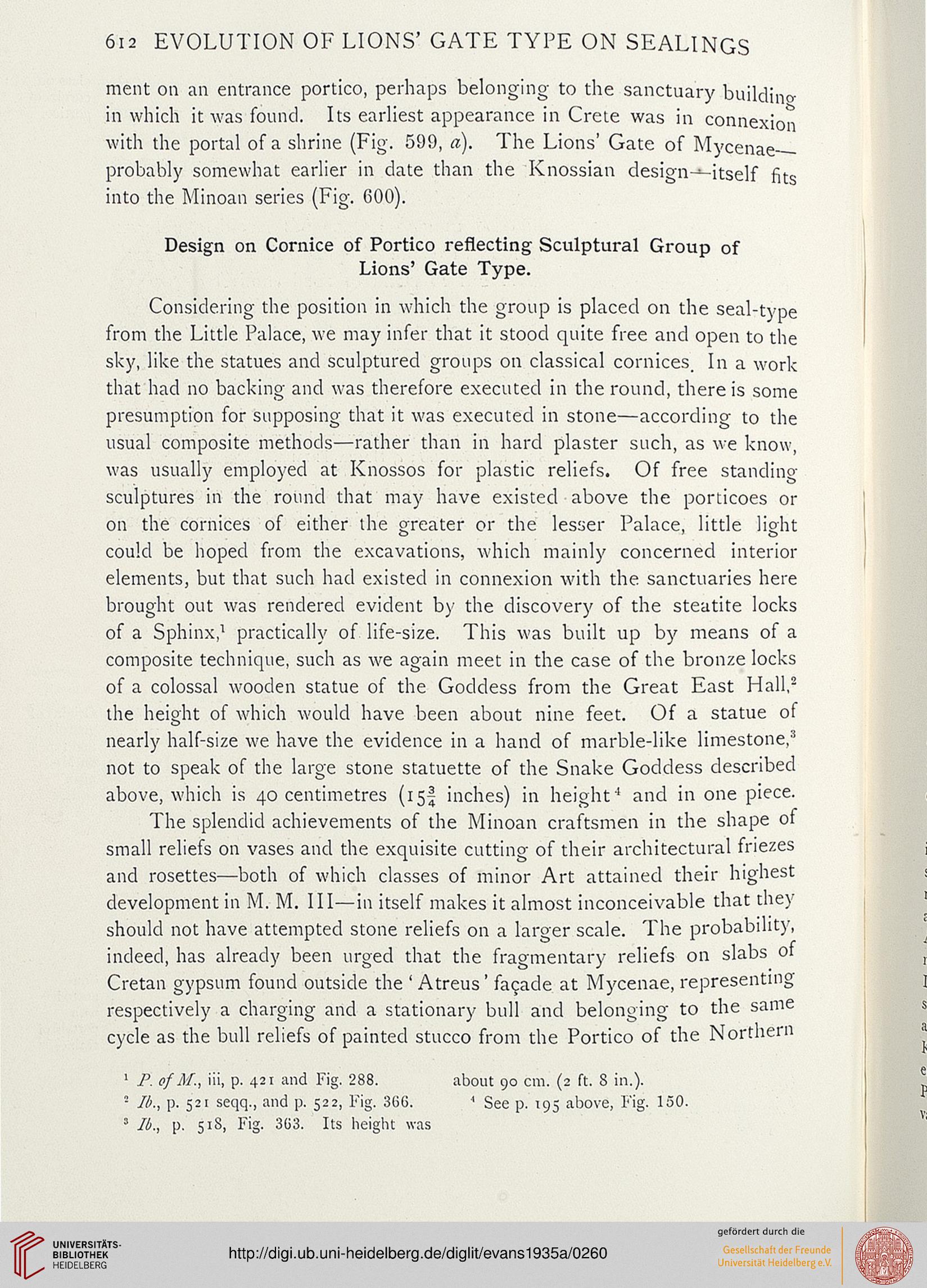612 EVOLUTION OF LIONS' GATE TYPE ON SEALINGS
ment on an entrance portico, perhaps belonging to the sanctuary building
in which it was found. Its earliest appearance in Crete was in connexion
with the portal of a shrine (Fig. 599, a). The Lions' Gate of Mycenae__
probably somewhat earlier in date than the Knossian design-*-itself fits
into the Minoan series (Fig. GOO).
Design on Cornice of Portico reflecting Sculptural Group of
Lions' Gate Type.
Considering the position in which the group is placed on the seal-type
from the Little Palace, we may infer that it stood quite free and open to the
sky, like the statues and sculptured groups on classical cornices. In a work
that had no backing and was therefore executed in the round, there is some
presumption for supposing that it was executed in stone—according to the
usual composite methods—rather than in hard plaster such, as we know,
was usually employed at Knossos for plastic reliefs. Of free standing
sculptures in the round that may have existed above the porticoes or
on the cornices of either the greater or the lesser Palace, little light
could be hoped from the excavations, which mainly concerned interior
elements, but that such had existed in connexion with the sanctuaries here
brought out was rendered evident by the discovery of the steatite locks
of a Sphinx,1 practically of life-size. This was built up by means of a
composite technique, such as we again meet in the case of the bronze locks
of a colossal wooden statue of the Goddess from the Great East Hall,2
the height of which would have been about nine feet. Of a statue of
nearly half-size we have the evidence in a hand of marble-like limestone,3
not to speak of the large stone statuette of the Snake Goddess described
above, which is 40 centimetres (15I inches) in height4 and in one piece.
The splendid achievements of the Minoan craftsmen in the shape of
small reliefs on vases and the exquisite cutting of their architectural friezes
and rosettes—both of which classes of minor Art attained their highest
development in M. M. Ill—in itself makes it almost inconceivable that they
should not have attempted stone reliefs on a larger scale. The probability,
indeed, has already been urged that the fragmentary reliefs on slabs of
Cretan gypsum found outside the ' Atreus' fa9ade at Mycenae, representing
respectively a charging and a stationary bull and belonging to the same
cycle as the bull reliefs of painted stucco from the Portico of the Northern
1 P. of M., iii, p. 421 and Fig. 288. about 90 cm. (2 ft. S in.).
"- lb., p. 521 seqq., and p. 522, Fig. 366. ' See p. 195 above, Fig. 150.
1 lb., p. 518, Fig. 363. Its height was
ment on an entrance portico, perhaps belonging to the sanctuary building
in which it was found. Its earliest appearance in Crete was in connexion
with the portal of a shrine (Fig. 599, a). The Lions' Gate of Mycenae__
probably somewhat earlier in date than the Knossian design-*-itself fits
into the Minoan series (Fig. GOO).
Design on Cornice of Portico reflecting Sculptural Group of
Lions' Gate Type.
Considering the position in which the group is placed on the seal-type
from the Little Palace, we may infer that it stood quite free and open to the
sky, like the statues and sculptured groups on classical cornices. In a work
that had no backing and was therefore executed in the round, there is some
presumption for supposing that it was executed in stone—according to the
usual composite methods—rather than in hard plaster such, as we know,
was usually employed at Knossos for plastic reliefs. Of free standing
sculptures in the round that may have existed above the porticoes or
on the cornices of either the greater or the lesser Palace, little light
could be hoped from the excavations, which mainly concerned interior
elements, but that such had existed in connexion with the sanctuaries here
brought out was rendered evident by the discovery of the steatite locks
of a Sphinx,1 practically of life-size. This was built up by means of a
composite technique, such as we again meet in the case of the bronze locks
of a colossal wooden statue of the Goddess from the Great East Hall,2
the height of which would have been about nine feet. Of a statue of
nearly half-size we have the evidence in a hand of marble-like limestone,3
not to speak of the large stone statuette of the Snake Goddess described
above, which is 40 centimetres (15I inches) in height4 and in one piece.
The splendid achievements of the Minoan craftsmen in the shape of
small reliefs on vases and the exquisite cutting of their architectural friezes
and rosettes—both of which classes of minor Art attained their highest
development in M. M. Ill—in itself makes it almost inconceivable that they
should not have attempted stone reliefs on a larger scale. The probability,
indeed, has already been urged that the fragmentary reliefs on slabs of
Cretan gypsum found outside the ' Atreus' fa9ade at Mycenae, representing
respectively a charging and a stationary bull and belonging to the same
cycle as the bull reliefs of painted stucco from the Portico of the Northern
1 P. of M., iii, p. 421 and Fig. 288. about 90 cm. (2 ft. S in.).
"- lb., p. 521 seqq., and p. 522, Fig. 366. ' See p. 195 above, Fig. 150.
1 lb., p. 518, Fig. 363. Its height was




